This portrait bust of Julius Caesar has been found at the bottom of the Rhone River at Arles, France.
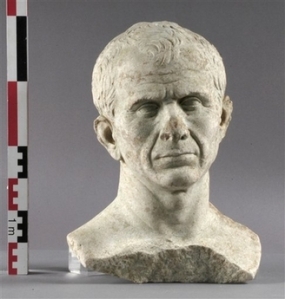 Photo from the CBC NEWS
Photo from the CBC NEWS
Archaeologists believe it was sculpted while he was still alive, perhaps two years before his assassination. Since it is clearly not an idealized portrait but a study from life, the bust shows what Caesar really looked like.
Marble bust of Caesar discovered in 2007 in the Rhone River near Arles, France. (Creative Commons Attribution-Share Alike 3.0 Unported, 2.5 Generic, 2.0 Generic and 1.0 Generic license photo by Mcleclat)
It has forced many to re-consider their hero.
“He doesn’t look like the kind of guy who would let himself get assassinated or worry about adjusting his garments in death,” said one scholar. “This Caesar image has close-set eyes and a pugilistic face, possibly affected by the bust’s damaged nose. Not the smooth intellectual face of someone who was famous for using clemency toward his defeated enemies as a political tool.”
Yet others see the portrait as a fine illustration (nature’s) of the general who conquered Gaul, created a Civil War, and became Dictator. He was no romantic. Clemency was a political tool and there were times when he opted for others (a club). Read Suetonius and see how brutal he could be.
Experts like Mary Beard and Paul Zanker doubt that this Arles bust represents Julius Caesar. See this article.
All the extant portraits but one were known to have been carved after Caesar’s death and were therefore artists’ inventions.
A favorite one has always been this noble head in the Vatican Museum.
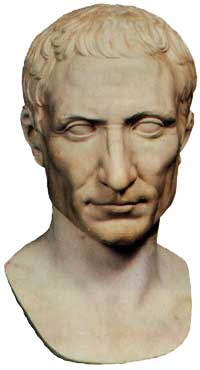 Bust of Caesar in the Vatican Collection (public domain photo)
Bust of Caesar in the Vatican Collection (public domain photo)
An engraving of its profile was used as a frontispiece for James Anthony Froude’s famous Victorian biography. He admires Caesar no end and denies or justifies and forgives all the evil deeds Suetonius and others record. In his last chapter Froude even compares him to Jesus Christ. Froude saw all his hero’s almost supernatural virtues reflected in this Vatican Museum portrait.
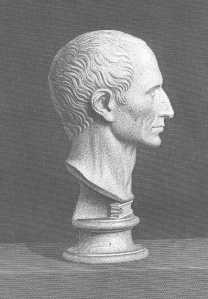 Frontispiece of Froude’s Caesar: A Sketch (file photo)
Frontispiece of Froude’s Caesar: A Sketch (file photo)
The one bust that was known to have been carved in Caesar’s lifetime has usually been ignored. It is so realistic it seems crude. It shows too definite a man and one who does not seem to embody all those mythical qualities of the hero, at least the likeable ones. Its profile is slightly more satisfying.
Tusculum portrait of Caesar (public domain photo by Tataryn77)
.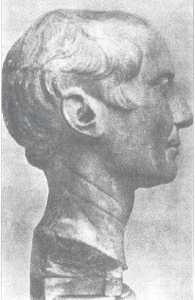 .Tusculum bust, profile (file photo)
.Tusculum bust, profile (file photo)
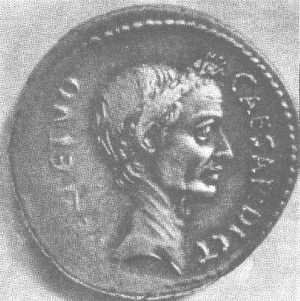 This is a coin minted during Caesar’s brief period as dictator ( file photo). In common with nearly all the other portraits, it shows his long, thin neck with deep parallel furrows, perhaps scars of some kind. The large eyes must be only an artistic device.
This is a coin minted during Caesar’s brief period as dictator ( file photo). In common with nearly all the other portraits, it shows his long, thin neck with deep parallel furrows, perhaps scars of some kind. The large eyes must be only an artistic device.
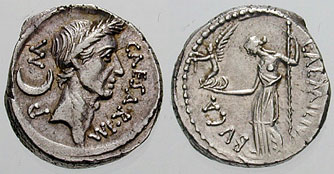 Another coin minted while Caesar was alive, February-March 44 BC. (Commons Attribution-Share Alike 3.0 Unported license photo by Classical Numismatic Group, Inc. )
Another coin minted while Caesar was alive, February-March 44 BC. (Commons Attribution-Share Alike 3.0 Unported license photo by Classical Numismatic Group, Inc. )
See also this bust of Caesar in the Archaeological Museum of Palermo. Some believe it was based on a death mask. There are two views at Jona Lendering’s page on Caesar. Scroll down the page and click on Caesar’s Funeral Mask.
..
..

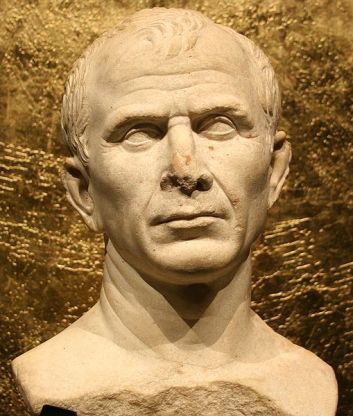
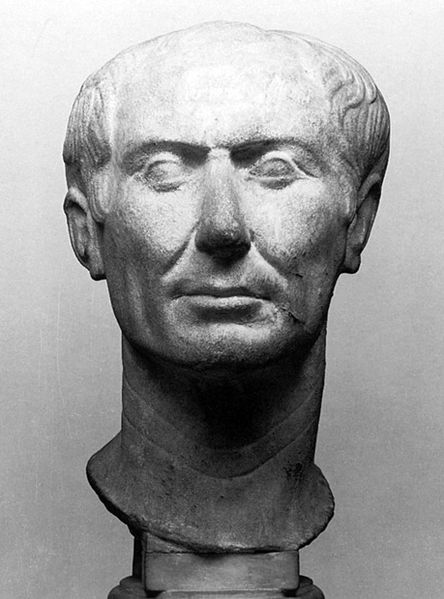


I’m afraid that 30th degree Mason would be wrong about the use of Caesar’s bones to reconstruct his likeness. The Romans of that time preferred cremation. They believed that cremation was the only way a person’s spirit could be released to cross the River Styx to the land of the dead. The ashes and whatever remained of the bones and teeth were then placed in an urn and that was buried.
Clearly, these are all different men, so how can they all be Julius Caesar? Where is there an inscription on any of them, so that we can know for sure? Someone declaring it to be so doesn’t make it so. These could be literally any blokes who bothered to pay an artist to make their portraits in marble. “Archaeologists believe it was sculpted while he was still alive, perhaps two years before his assassination.” Oh, so they BELIEVE, do they? On what basis? There are no photographs for comparison. If any old bust dug out of a river can be Julius Caesar, then how do we know any of the ancient busts are who we are told they are? They could dig up a bust of a bearded guy and claim it was Plato or Socrates, for example…and have, in fact, done so. How do they KNOW–not merely believe, but KNOW–that those busts belonged to those gentlement?
Yes, the sculptor often literally carved the depicted person’s name into the sculpture or bust. It’s called a signifying or commemorative plaque. They would also regularly carve THEIR name, the artist’s name, into the finished work. Michaelangelo carved his name into the Pieta and many, many other famous masterpieces. Sometimes they would also depict the artist as well as the patron who commissioned it, seen in many donor portraits.
Not to mention the written account that would go along with the sculpture and would have been kept in libraries or archives. There also would have been the financial transaction record of the commission between patron and artist. Identifying the subject is harder when someone like Caesar or Nero fell out of favor and people destroyed the likenesses of them, the name plaque would be among the first things destroyed (along with the face).
Today, they can easily use radiocarbon dating on the bust or sculpture to both establish provenance as well as date the work to a specific year, period or rule of a leader. Science can work well with art and answers many questions that could never be known for sure.
Just curious .. how do we know that the busts and statues found actually were the images of Caesar (or any other statue of anybody?) Was their name on it somewhere?
he was an unhappy soldier
I like this l
If you want to see what Julius Caesar looked like, look at a photo of Vladimir Putin. He is a clone that they made from Caesar’s bones. They only need one cell with DNA to clone. A 30 degree Freemason told me. Putin even has Caesar’s personality traits: a pagan pedophile who throws children and women to wild cats in a satanic ritual to harness power from their souls as they die; or terrorise them before he sacrifices them to purify their souls and extract more power from them. Google 9th Circle. It is based on ancient paganism. Freemasonry at the higher levels is a modern version of it. Putin has gradually had the huge nose he was born with shaved down over the years. Now it is nothing but a scoop on his face with a small knob on the end. When he was younger (see the pic with his teenage girlfriend and the one in his furry toque) his nose was HUGE with a big crooked bump on the ridge and a large knob on the end. It was exactly like the original coins of Caesar. Putin has the receding chin that Caesar had too. His head shape is the same. His cheekbones, eye shape and position. Take all the furrows off because Putin uses Botox, and they look exactly the same. He was cloned by the Masons to rule the New World Order Roman Empire. Dopplegangers, and there are countless ones, supposedly 7 per person which makes 6.?b for the world population of 7b, are clones that must have been switched at birth for human babies. The Freemasons consider a human sacrifice much more valuable as it has a soul and they harness more power from it. They also clone humans and sacrifice them but they are inferior and only enable the Masons to gain strength while the clone flesh is in them in order to harness power from humans when they murder them. True story. Read the Twitter convo with the 30 degree mason on YouTube: videos of Teresa Marie.
Mikr Burns: Thanks for your well-written contribution. Maybe the ruthless reality of the Arles bust plausibly aligns with some of Caesar’s traits but not with the ones I admire, so I will go on mentally modelling my version. The “ruthless and determined” ones stand out in this bust and do align with Cicero’s take on the man.
I know it is probably a futile diversion, but great men of whatever persuasion who stride the annals of history with the might of Caesar, fire a kudos and fascination within a modern society, which is in his case, inevitably enhanced by the mystery of the great distance of time that separates us.
Of course we yearn to know the countenance of a man of such staggering world-beating achievement! Anyone reading history and in possession of even an ounce of imagination cannot help but wonder what he looked like. Ruthless and determined, courageous but charming, brilliant and perceptive, quick thinking and decisive, and possessed of guile and astonishing physical stamina, and of course a huge success with the ladies; Caesar (according to contemporary reports from the likes of Seutonius), -had it all!
Still, civic opinion in its efforts to erase any imperfection has an annoying habit of modelling the statutory of its heroes (especially those for which there is such scant physical evidence) into a kind of bland sanctified amalgam of expression that robs it of all reality.
I suppose the evidence for Caesar’s exact appearance will always be tantalizingly out of reach, but for my money, the bust recently dragged from the river at Aries is probably as close as we’re going to get. Dating suggests it was made during the man’s life, and for me this image with its ‘less than classical perfection’, has nonetheless, a lithe alertness and a ruthless reality of expression that none of the others quite match, yet plausibly align with at least some of the known traits of his character.
In a documentary on the BRITISH BBC, in which the historian (lady) states that Caesar was famous for being an authentic Casanova, I had the confirm of what I always knew: he was extremely powerful ok, but probably wasn’t that ugly as the books describe Socrates or Attila ..
It could be that many of the busts you see weren’t made with him standing by..
or probably.. he tried to look more uglier then he really was in order to look more a warrior.. and less a playboy
Or probably he was the ugliest man of his times and because of his “myth”.. he became beautiful..
hablamos pronto
James
Thanks ALu: I’m all too glad if the bust found in the river wasn’t Caesar’s. As for the crude look of the Turin portrait, there are realisms and realisms. If the model really was Caesar, all his greatness was invisible to that sculptor, who fits the stereotype of the Roman with no imagination, not even for “realism”, which, remember, is also an invention.
Much ado about nothing.
As you can read up on Wikipedia, there is nothing to tie the Arles river bust to Caesar. Just a nice tale as to why it could have ended up in the river.
As for the Turin and Palermo busts, they don’t have very much in common. And that the crudest has to be the most realistic is a funny argument.
Happy Caesar-hunting! I prefer the Vatican bust. It’s the most pleasing and has common features with the rough one from Turin, so we can assume that Caesar’s real face must lie somewhere in between.
Grazie, Viviana. Grande mistèro il termine s….
giulio cesare e stato veramente un grande e poi era anche coraggioso forte e leale chi lo ha ucciso è veramente uno s……………….. scusate il termine. cmn madame monet ha ragione tra quei volti il più bello è quello che hanno trovato nel fiume!!
Right, Danu. The thing is, whenever you hear about some great man you can’t help but want to see what he looked like. As if you could see the greatness written on their face. Of course when I see the childish or weak and merely pretty faces of some Hollywood actors playing Alexander or Caesar or Napoleon I almost laugh. Sure–those men looked like THAT! Impossible!
What does it matter how he looked like? Myth and truth aren’t the same thing and very often, in great names case, the legend becomes a more persistent “truth” than the truth itself…
The first three show a similarities on his physiognomy. On the first one he looks like a brute; second: an intelligent man, a thinker; third: a soldier, fourth: well…hmm…a dumb or senile old man.
I think the most attractive of all these busts is the one that was fished out of the river.
Madame Monet